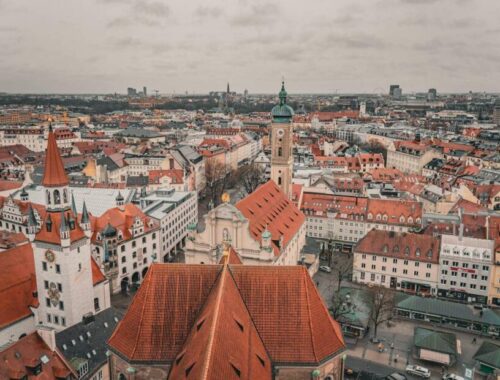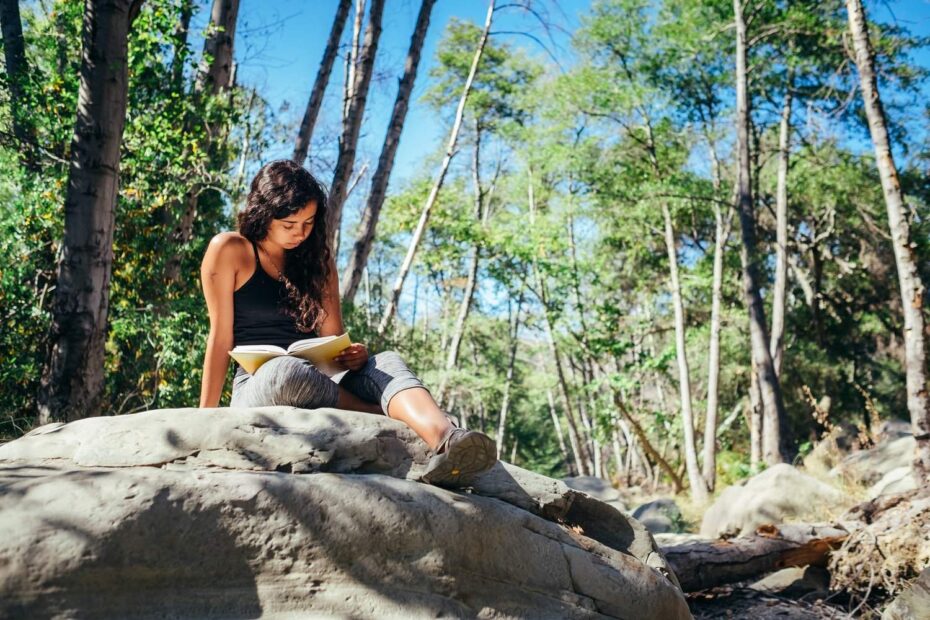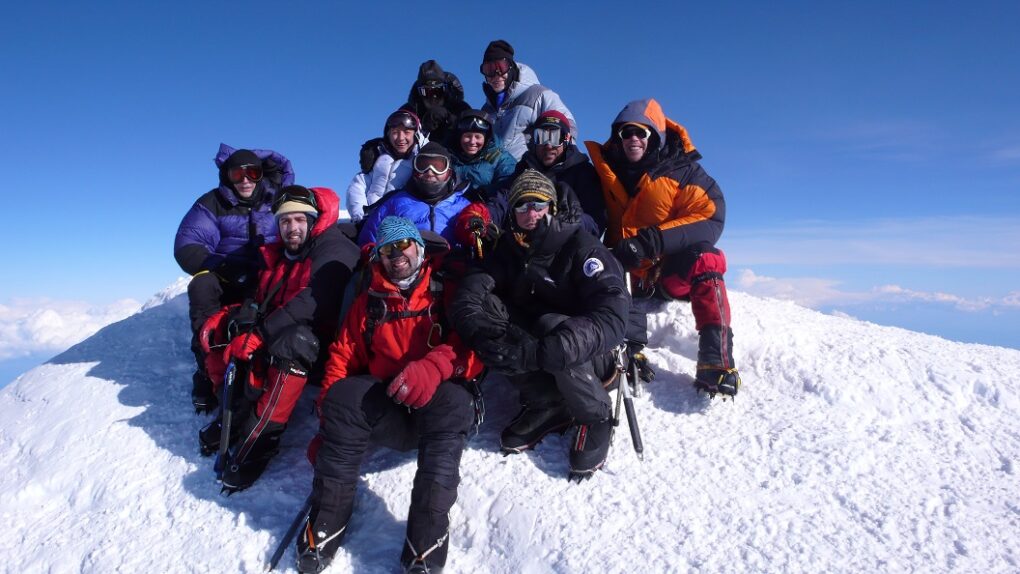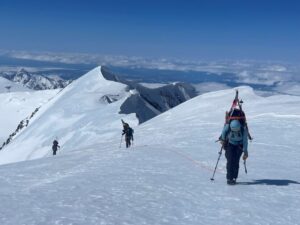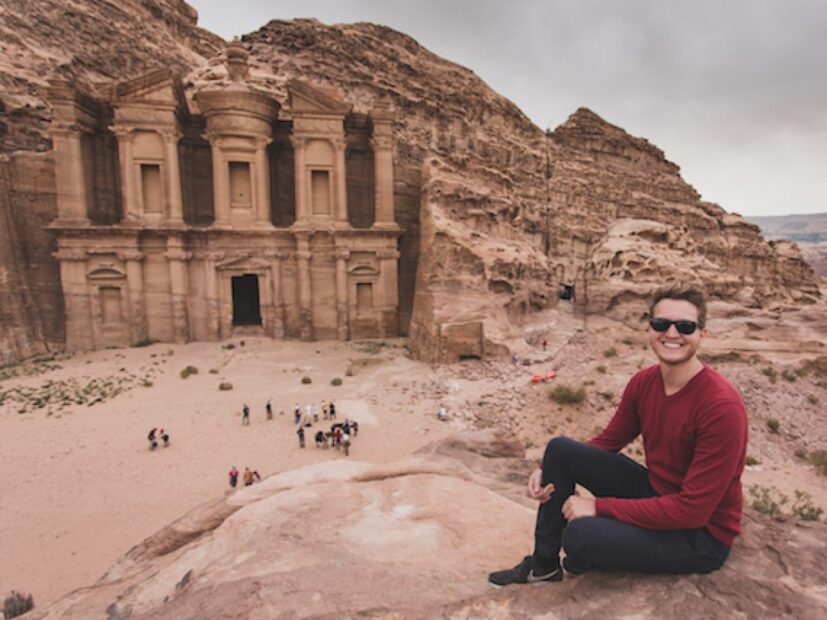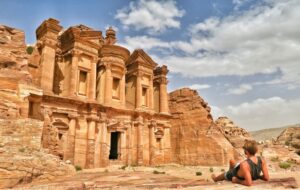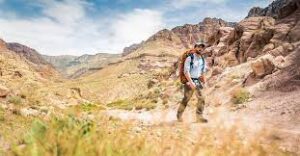When we pack our bags and set off to explore new horizons, it’s not just our spirits that need uplifting — our skin demands its share of care, too! Amidst the excitement of exploring new places, it’s easy to overlook our skin’s needs, leading to unwelcome souvenirs like dryness or sunburn. But how do you keep your skin pampered and protected while on the move? Let’s dive into the ultimate guide to keeping your skin radiant, no matter where your travels take you. Continue Reading
We all deserve to plan vacations whenever we like. We don’t even need a particular reason to want to leave our homes and explore new towns, cities, and countries. However, there may come a time when the desire to pack a suitcase and venture off somewhere new and exciting is even stronger than usual. You might relate to some of these signs: Continue Reading
Introduction
Climbing Denali: The adventure of a lifetime
Also known as Mount McKinley, Denali rises as the highest peak in North America, located in central Alaska. With a peak elevation of 20,310 feet (6,190 meters), its high altitude has attracted generations of climbers, drawing them to its challenging peaks and terrifying terrain
For climbers around the world, Denali represents a test of their ultimate ambition, skill, endurance and endurance like no other. Its size and harsh conditions make it a formidable challenge, but with the right preparation and guidance, the rewards of Mount Denali are unmatched.
Gear and Equipment
Detailed List of Essential Gear for Denali Climbing
- Climbing Gear:
- Mountaineering boots with rigid soles for traction and support.
- Crampons for ice climbing and navigating glacier terrain.
- Ice axe for self-arrest and stability on steep slopes.
- Climbing harness and carabiners for securing ropes and gear.
- Helmet for protection against falling debris and rockfall.
- Clothing:
- Insulated layers for warmth, including base layers, mid layers, and outer shells.
- Waterproof and windproof jacket and pants to protect against harsh weather conditions.
- Insulated gloves and mittens to prevent frostbite in cold temperatures.
- Warm hat or balaclava to retain heat and protect ears from frostbite.
- Sunglasses with UV protection to shield eyes from glare and snow blindness.
- Camping Equipment:
- Four-season tent designed to withstand high winds and snow loading.
- Sleeping bag rated for subzero temperatures to ensure warmth during cold nights.
- Sleeping pad or insulated mattress for insulation and comfort on snow and ice.
- Lightweight stove and fuel for melting snow and cooking meals at high altitude.
- High-altitude cookware and utensils for preparing and storing food.
- Safety Equipment:
- Avalanche beacon, shovel, and probe for backcountry travel in avalanche terrain.
- First aid kit with essential supplies for treating injuries and medical emergencies.
- GPS device or satellite communicator for navigation and emergency communication.
- Climbing rope and snow pickets for anchoring and rappelling on steep terrain.
- Personal Locator Beacon (PLB) or Satellite Emergency Notification Device (SEND) for summoning rescue assistance in case of emergencies.
Special equipment recommendations
- Invest in high quality products from reputable brands known for their durability and performance in mountainous areas.
- Choose shoes with good insulation and ankle support to avoid frostbite and injury from long days in the mountains.
- Choose clothing and accessories that are lightweight and compressable to reduce pack weight without compromising safety or comfort.
Navigation in gray and low visibility conditions
- Remain aware of your surroundings: Remain aware of your surroundings and your course even in gray conditions by paying attention to subtle ground objects and tools using navigation tools such as a compass and GPS.
- Rope Team Communication: Maintain strong communication with your rope team members to create a strategic plan and avoid straying off course. Use verbal and visual cues to communicate information and remain cooperative in challenging visual situations.
- Drive slowly and steadily: Reduce speed and proceed with caution in easy conditions to reduce the risk of mistakes or accidents during transit. Take frequent breaks and reassess your surroundings to check for progress along the way.
Communication and Emergency Protocols
Communication Devices Recommended for Denali Climbers
- Satellite Phone: Carry a satellite phone capable of functioning in remote areas with limited cellular coverage. Satellite phones provide reliable communication for emergency situations and essential updates to support teams.
- Two-Way Radios: Equip each member of your climbing team with two-way radios for real-time communication during the climb. Two-way radios facilitate coordination and quick decision-making, especially in challenging terrain or adverse weather conditions.
- Personal Locator Beacon (PLB): Carry a PLB as a last-resort emergency signaling device in case of life-threatening situations. PLBs transmit distress signals to search and rescue authorities, enabling prompt assistance in remote or hazardous environments.
Establishing Communication Protocols with Climbing Partners and Support Teams
- Pre-Trip Planning: Prior to the climb, establish communication protocols with your climbing partners and support teams to ensure effective coordination and response in various scenarios.
- Check-In Schedule: Agree upon a regular check-in schedule with designated times for communication updates between climbing teams and support personnel. Stick to the check-in schedule to maintain accountability and track progress.
- Emergency Codes: Develop a set of emergency codes or signals to communicate critical information quickly and discreetly during the climb. Use clear and concise messages to convey urgent situations and prompt appropriate responses.
Steps to Take in Case of an Emergency, Including Evacuation Procedures
- Assess the Situation: Evaluate the nature and severity of the emergency, prioritizing the safety and well-being of all individuals involved. Remain calm and focused, gathering relevant information to inform your decision-making process.
- Activate Emergency Response: Initiate the appropriate emergency response procedures based on the nature of the situation. Use communication devices to alert support teams and authorities, providing essential details such as location, injuries, and resources needed.
- Follow Evacuation Protocols: Implement evacuation protocols as necessary, coordinating with support teams to execute a safe and efficient evacuation plan. Follow established evacuation routes and procedures, prioritizing the evacuation of injured or vulnerable individuals.
- Continuously Communicate: Maintain open communication channels throughout the emergency response process, providing regular updates to support teams and authorities as the situation evolves. Keep all stakeholders informed of progress and any changes to the evacuation plan.
height and how they are changed
To understand the effect of altitude on the body
- Altitude refers to altitude above sea level and can have significant physiological effects on the body, especially as altitude increases.
- Air pressure decreases at higher altitudes, reducing the amount of oxygen in the atmosphere. This decrease in oxygen can contribute to high-altitude diseases such as altitude sickness, hypoxia, and high-grade pulmonary edema (HAPE).
Progressive strategies to avoid high-altitude disease
- Climb slowly: Climb slowly to higher altitudes, to give your body time to adjust to the thinner air and to lower oxygen levels. Avoid rapid altitude, especially above 10,000 feet (3,048 meters).
- Adequate hydration: Drink plenty of fluids, especially water, to maintain hydration at high altitudes. Dehydration can exacerbate altitude-related symptoms and increase the risk of altitude sickness.
- Rest and recovery: Include rest days in your climbing routine to give your body time to adjust to the altitude and recover from physical exertion. Avoid overexerting yourself, and listen to your body’s signals of fatigue or discomfort.
- Climb high, sleep low: Apply the “climb high, sleep low” principle by climbing to higher elevations during the day and descending to lower elevations for sleep. This approach encourages gradual environmental conditions and reduces the risk of illness at high altitudes.
- Medications: Consider taking medications such as acetazolamide (Diamox) to prevent or reduce symptoms of altitude sickness. Consult with your health care provider before using any products for height-related issues.
Conservation Efforts on Denali and How Climbers Can Contribute
- Denali National Park and Preserve is committed to preserving the natural beauty and ecological integrity of the area through various conservation initiatives.
- Climbers can contribute to conservation efforts by adhering to Leave No Trace principles, participating in volunteer programs, and supporting organizations dedicated to environmental stewardship.
- Take proactive measures to minimize environmental impact during climbs, such as avoiding unnecessary disturbance to wildlife and habitats, reducing waste generation, and advocating for sustainable climbing practices.
Weather Patterns and Climate Change Implications for Denali Climbing
- Denali’s weather is characterized by extreme cold, high winds, and frequent storms, posing significant challenges for climbers.
- Climate change is impacting Denali’s weather patterns, leading to increased temperatures, glacier retreat, and changes in precipitation patterns.
- Climbers should be prepared for unpredictable weather conditions and be vigilant about monitoring weather forecasts and conditions throughout the climb.
- Consider the implications of climate change on climbing safety and sustainability, including potential hazards such as melting permafrost, unstable glaciers, and increased risk of avalanches.
Logistics and Planning
Obtaining Permits and Arranging Transportation to Denali
- Permit Application: Apply for climbing permits through the National Park Service (NPS) website or designated permit offices. Ensure compliance with permit requirements and regulations.
- Transportation Options: Explore transportation options to reach Denali, including flights to nearby airports such as Fairbanks or Anchorage, followed by ground transportation to the park entrance.
Logistics of Getting to Base Camp and Organizing Support Services
- Access Routes: Choose a preferred access route to Denali’s base camp, considering factors such as terrain difficulty, distance, and logistical support available along the route.
- Support Services: Arrange support services such as gear transportation, food resupply, and medical assistance through authorized guiding companies or independent outfitters.
Considerations for International Climbers and Travel Logistics
- Visa and Immigration: Ensure compliance with visa and immigration requirements for international travel to the United States. Allow sufficient time for visa processing and documentation.
- Travel Insurance: Obtain travel insurance coverage for international climbers to mitigate risks associated with travel delays, medical emergencies, and trip cancellations.
- Language and Cultural Considerations: Familiarize yourself with English language requirements and cultural norms in the United States to facilitate communication and integration during your climb.
Mental Health and Well-being
Coping Strategies for Isolation and Extended Periods in Harsh Conditions
- Establish Routines: Create daily routines to provide structure and stability, even in challenging environments. Routines can help alleviate feelings of isolation and uncertainty.
- Stay Connected: Maintain regular communication with climbing partners, support teams, and loved ones through satellite phones, two-way radios, or written correspondence. Sharing experiences and emotions can provide comfort and support.
- Engage in Activities: Stay mentally stimulated by engaging in activities such as journaling, reading, or playing games during downtime. Keeping the mind occupied can help distract from negative thoughts and feelings.
- Focus on Goals: Set achievable goals and milestones to maintain motivation and a sense of purpose. Celebrate accomplishments, no matter how small, to boost morale and confidence.
Importance of Self-care and Maintaining Mental Health During the Climb
- Prioritize Rest and Recovery: Adequate rest is essential for mental and physical well-being. Ensure sufficient sleep and relaxation time between climbs to prevent burnout and exhaustion.
- Hydration and Nutrition: Stay hydrated and nourished with a balanced diet to support overall health and energy levels. Proper nutrition is vital for maintaining mental clarity and resilience.
- Manage Stress: Practice stress management techniques such as deep breathing, meditation, or mindfulness exercises to reduce anxiety and promote relaxation.
- Seek Support: Don’t hesitate to seek support from climbing partners, support teams, or mental health professionals if experiencing emotional distress or psychological challenges. It’s okay to ask for help when needed.
Post-Climb Recovery and Reflection
Importance of Proper Rest and Recovery After Completing the Climb
- Physical Rest: Allow your body sufficient time to rest and recover from the physical exertion of the climb. Adequate sleep, hydration, and nutrition are essential for rebuilding muscle strength and replenishing energy stores.
- Mental Recovery: Take time to decompress mentally and emotionally after the climb. Reflect on your experiences, process any emotions or challenges encountered during the expedition, and practice self-care techniques to promote mental well-being.
- Injury Management: Attend to any injuries or ailments that may have occurred during the climb. Seek medical attention if necessary, and follow recommended treatments and rehabilitation protocols to ensure full recovery.
Reflecting on the Experience and Lessons Learned
- Journaling: Write down your thoughts, feelings, and experiences from the climb in a journal or diary. Reflect on the highs and lows, memorable moments, and personal achievements. Consider what you learned about yourself, your abilities, and your limitations.
- Group Discussion: Engage in discussions with climbing partners, mentors, or fellow climbers to share insights and perspectives on the climb. Exchange stories, lessons learned, and tips for future endeavors. Celebrate successes and support each other through challenges.
- Self-Reflection: Take time for introspection and self-reflection to gain deeper insights into your motivations, fears, and aspirations. Consider how the climb has impacted you personally, professionally, and spiritually, and identify areas for growth and development.
Setting New Goals and Aspirations for Future Mountaineering Endeavors
- Goal Setting: Establish new goals and aspirations based on your experiences and reflections from the climb. Whether it’s conquering a higher peak, mastering a new climbing technique, or exploring a different terrain, set clear and achievable goals to guide your future mountaineering endeavors.
- Training and Preparation: Develop a training plan tailored to your goals, focusing on areas that require improvement or development. Incorporate strength training, cardiovascular conditioning, and technical skills practice to enhance your climbing abilities and preparedness for future challenges.
- Community Engagement: Stay connected with the mountaineering community through participation in events, workshops, and expeditions. Seek out opportunities to learn from experienced climbers, share knowledge and experiences with others, and contribute to the growth and development of the climbing community.
conclusion
- Climbing Denali is a challenging and rewarding endeavor that requires careful planning, preparation and respect for the environment. By obtaining a permit, understanding the challenges, and implementing Leave No Trace principles, climbers can have a safe and memorable trip to North America’s highest peak Remember to inform, stay safe, and you’ll enjoy your trip to Denali.
Backpacking Jordan: Top 10 Tips for an Unforgettable Adventure
introduction
With its rich history, diverse landscapes and warm hospitality, Jordan attracts travel buffs around the world to explore its wonders. Located in the heart of the Middle East, this small but mighty country offers a myriad of experiences for backpackers looking for adventure, culture and natural beauty
Important for hiking and camping
Here are some other important packs for backpackers planning to explore Jordan’s rugged terrain and wilderness areas:
- Water bottle or water dispenser: Stay hydrated on the trails by carrying a refillable water bottle or water dispenser. If you want fresh water from natural springs, consider bringing water purifiers or filters.
- Navigational devices: Bring a map, compass, or GPS device to navigate unfamiliar terrain, especially when traveling in remote areas. Become familiar with the trail route and facilities before you set out.
- First aid kit: Carry a compact first aid kit with essential items such as bandages, disinfectants, pain relief and allergy treatment. Bring any personal medications you may need during the trip.
- Emergency shelter: Take a light shelter, such as a compact tent or double-sided bag, in case you need a place to sleep overnight due to unforeseen circumstances.
- Meals and snacks: Pack healthy light snacks like fruit, dried fruit, granola bars and trail mix to enhance your trail adventures. Don’t forget to install a portable stove or cooking fire for preparing meals at your campsite.
Advice on taking public transportation and renting a car
Taking public transportation and renting a car in Jordan can be easy when you are prepared and have the right knowledge:
- Plan ahead: Investigate travel options and schedules in advance, especially for long trips or trips to remote locations. Websites and apps like Jordan Transport Map and Google Maps can help you find routes, schedules and fare information.
- Official taxi stands: Use official taxi stands or book through popular taxi apps to ensure safety while taking a taxi and avoid fraud. Before starting your journey, agree to the fare and confirm that the taxi meter is working.
- Negotiate a car rental: When renting a car, discuss the terms and price with the rental company to ensure a fair deal. Check the condition of the vehicle thoroughly before acceptance and note any existing damage.
- Watch traffic: Traffic jams can be common in cities, especially during rush hour. Plan your travel time accordingly to avoid delays and extra time to manage traffic.
- Safety: Use caution when using public transportation or driving in Jordan, especially in rural or unfamiliar areas. Keep your valuables, observe your surroundings and trust your instincts.
Tips on budgeting and managing expenses while traveling
To make the most of your budget when backpacking in Jordan, consider the following tips for budgeting and managing expenses.
- Research and plan ahead: Research accommodation, food and activity costs in advance so you can budget appropriately for your trip. Look for easy options and prioritize activities that meet your interests and budget constraints.
- Track your expenses: Track your daily expenses with a simple travel budget app or spreadsheet. Monitor your spending regularly to identify areas where you can cut back and adjust your budget accordingly.
- Cook your own food: Save money on food by cooking your own food whenever possible. Hotels and guesthouses often offer kitchens where you can prepare simple meals with local ingredients from markets and shops.
- Use public transportation: Opt for cheap transportation such as buses, minibuses and shared taxis to get around. Avoid spending unnecessarily on private taxis or rental cars unless it is necessary in your travel plans.
- Take advantage of free activities: Look for free or low-cost activities and attractions to explore during your trip. Many museums, parks and cultural centers offer free or discounted admission on certain days.
- Don’t negotiate prices: Don’t be afraid to negotiate prices, especially when shopping at the market or hiring local workers. Negotiation is a common practice in Jordan, so sharpen your negotiation skills and aim to get the best value for your money.
Must-See Destinations and Activities
Petra: The Rose City
Explore the iconic archaeological site of Petra, a UNESCO World Heritage Site known for its stunning rock-cut architecture and fascinating history.
- Overview: Petra, also known as the Rose City due to the pink hue of its sandstone cliffs, was the capital of the Nabatean Kingdom and is now one of Jordan’s most famous attractions.
- Key Features:
? The Treasury (Al-Khazneh): Marvel at the intricate façade of the Treasury, carved directly into the sandstone cliff, and discover its archaeological significance.
? The Siq: Walk through the narrow gorge of the Siq, a natural geological formation that serves as the main entrance to Petra, and admire the stunning rock formations along the way.
? The Monastery (Ad Deir): Hike to the Monastery, another impressive monument carved into the cliffside, and enjoy panoramic views of Petra from the top.
- Insider Tip: Beat the crowds by arriving early in the morning or late in the afternoon to experience Petra in a more serene atmosphere. Avoid visiting during peak tourist seasons to enjoy a quieter and more immersive experience.
Wadi Rum: The Valley of the Moon
Embark on a desert adventure in Wadi Rum, where you can marvel at towering sandstone cliffs, go on a thrilling jeep safari, and camp under a blanket of stars.
- Overview: Wadi Rum, also known as the Valley of the Moon, is a vast desert landscape characterized by dramatic sandstone mountains, red sand dunes, and ancient rock carvings.
- Key Features:
? Jeep Safari: Explore the desert terrain on a thrilling jeep safari tour, led by knowledgeable Bedouin guides who will take you to hidden gems and panoramic viewpoints.
? Camping: Experience Bedouin hospitality by spending a night under the stars at a traditional desert campsite, complete with traditional meals, storytelling, and stargazing.
? Rock Climbing: Test your skills on the rugged sandstone cliffs of Wadi Rum, a popular destination for rock climbers of all levels.
- Insider Tip: Opt for a guided tour with a local Bedouin guide to gain insight into the culture and traditions of the desert nomads. Learn about Bedouin customs, folklore, and survival techniques while exploring the breathtaking landscapes of Wadi Rum.
Dead Sea: The lowest point on earth
Immerse yourself effortlessly in the warm waters of the Dead Sea, known for its high salt content and mineral-rich mud.
- Overview: The Dead Sea is a salt lake bordered by Jordan to the east and the West Bank of Israel to the west. It is one of the saltiest bodies of water in the world, making it a unique destination for travelers seeking a therapeutic experience.
- Floating Experience:
? Discover how weightless it is to float effortlessly on the surface of the Dead Sea, thanks to the extraordinarily high salinity, which is about 10 times saltier than the sea
? Enjoy the feeling of floating effortlessly while taking in the breathtaking views of the wilderness surroundings.
- Mineral mud:
? Take a dip in the mineral-rich algae found on the shores of the Dead Sea, known for their healing and skin rejuvenation properties
? Let the mud dry on the skin before rinsing with running water, leaving your skin soft, smooth and fresh
- Insider Tip: Don’t forget to stick to therapeutic mud baths to keep your skin warm and relaxed. Many resorts near the Dead Sea offer spa treatments and mud baths as part of their health packages.
Amman: The Capital City
Immerse yourself in the vibrant culture of Amman, where ancient landmarks coexist with modern amenities.
- Overview: Amman, the capital city of Jordan, is a bustling metropolis known for its rich history, vibrant culture, and warm hospitality. From ancient ruins to contemporary art galleries, Amman offers a diverse array of experiences for visitors to explore.
- Historical Landmarks:
? Visit the Citadel, perched atop Jabal al-Qal’a, to discover ancient ruins dating back to the Roman, Byzantine, and Umayyad periods, including the iconic Temple of Hercules and the Umayyad Palace.
? Explore the Roman Theater, a well-preserved amphitheater that once hosted theatrical performances and gladiatorial contests during the Roman Empire.
- Cultural Attractions:
? Wander through the bustling markets of Downtown Amman, known as Al-Balad, to sample traditional street food, browse for souvenirs, and soak up the lively atmosphere of this vibrant neighborhood.
? Visit the Jordan Museum to delve into the country’s rich history and heritage through its extensive collection of archaeological artifacts, including the famous Dead Sea Scrolls.
- Insider Tip: Explore the bustling markets of Downtown Amman, sampling traditional street food and browsing for souvenirs. Don’t miss the opportunity to savor local delicacies such as falafel, shawarma, and kunafa while immersing yourself in the sights and sounds of the city.
Jerash: The Roman Ruins
Step back in time at the ancient city of Jerash, home to some of the best-preserved Roman ruins outside of Italy.
- Overview: Jerash, located in northern Jordan, is an archaeological site known for its remarkably well-preserved Roman ruins. It offers visitors a glimpse into the grandeur of ancient Roman civilization in the heart of the Middle East.
- Key Features:
? Hadrian’s Arch: Marvel at the triumphal arch built to honor the visit of Emperor Hadrian to Jerash in AD 129.
? Oval Plaza: Explore the vast plaza surrounded by colonnades, once used for public gatherings, ceremonies, and performances.
? South Theater: Admire the ancient theater, which dates back to the 1st century AD and could accommodate up to 3,000 spectators.
- Insider Tip: Visit during the Jerash Festival of Culture and Arts for a chance to witness live performances and cultural events against the backdrop of the ruins. The festival, held annually in July, showcases traditional music, dance, and theater, bringing Jerash’s ancient past to life in a vibrant celebration of Jordanian culture.
Dana Biosphere Reserve: Nature’s Playground
Hike through the diverse landscapes of the Dana Biosphere Reserve, home to rugged mountains, verdant valleys, and rare wildlife.
- Overview: The Dana Biosphere Reserve is Jordan’s largest nature reserve, encompassing a variety of ecosystems, from rocky mountains to desert plains. It offers outdoor enthusiasts the opportunity to explore pristine wilderness and encounter diverse flora and fauna.
- Key Features:
? Scenic Trails: Embark on hiking trails that wind through the reserve’s diverse landscapes, offering stunning views of rocky cliffs, lush valleys, and winding rivers.
? Wildlife Viewing: Keep an eye out for rare and endangered species that inhabit the reserve, including Nubian ibex, Syrian serin, and sand cats.
? Eco-Lodges: Stay overnight at one of the eco-lodges within the reserve for a truly immersive experience in nature. These sustainable accommodations offer comfortable amenities while minimizing their environmental impact.
- Insider Tip: Plan your visit during the spring or fall months for the best weather and optimal hiking conditions. Be sure to pack plenty of water, sunscreen, and sturdy hiking shoes, as temperatures can fluctuate and trails can be rugged.
Aqaba: Gateway to the Red Sea
Discover the underwater wonders of the Red Sea in Aqaba, where you can snorkel, dive, or simply relax on pristine beaches.
- Overview: Aqaba is a coastal city located on the Red Sea in the southern tip of Jordan. It is renowned for its crystal-clear waters, vibrant coral reefs, and diverse marine life, making it a paradise for underwater enthusiasts and beach lovers alike.
- Key Attractions:
? Snorkeling and Diving: Immerse yourself in the vibrant underwater world of the Red Sea by snorkeling or diving at popular sites such as the Japanese Garden and Cedar Pride wreck. Explore colorful coral reefs teeming with tropical fish, sea turtles, and other marine creatures.
? Beaches: Relax and unwind on Aqaba’s pristine beaches, where you can soak up the sun, swim in the warm waters of the Red Sea, or indulge in water sports such as jet skiing, parasailing, and banana boating.
- Insider Tip: Explore the vibrant coral reefs and marine life at sites like the Japanese Garden and Cedar Pride wreck. Consider joining a guided snorkeling or diving tour led by experienced local instructors to discover hidden gems and maximize your underwater experience.
Madaba: The City of Mosaics
Marvel at the intricate mosaic artworks that adorn the churches and museums of Madaba, including the famous Madaba Map.
- Overview: Madaba, often referred to as the “City of Mosaics,” is renowned for its exquisite Byzantine and Umayyad mosaic artworks, which adorn churches, mosques, and public buildings throughout the city. The highlight of Madaba’s mosaic heritage is the famous Madaba Map, a 6th-century mosaic map of the Holy Land.
- Key Attractions:
? Madaba Map: Visit the Greek Orthodox Church of St. George to admire the stunning Madaba Map, a mosaic floor map depicting the biblical sites of the Holy Land, including Jerusalem, Bethlehem, and the Dead Sea.
? Mosaic Workshops: Learn about the ancient art of mosaic-making and watch skilled artisans at work at the Madaba Institute for Mosaic Art and Restoration. Participate in hands-on mosaic workshops to create your own mosaic masterpiece under the guidance of expert instructors.
- Insider Tip: Don’t miss the opportunity to learn the art of mosaic-making from local artisans at the Madaba Institute for Mosaic Art and Restoration. Gain insight into the intricate techniques and meticulous craftsmanship involved in creating these stunning works of art, and take home a unique souvenir of your visit to Madaba.
Mount Nebo: Panoramic Views
Take in sweeping views of the Jordan Valley and the Promised Land from the summit of Mount Nebo, where Moses is said to have glimpsed the Holy Land.
- Overview: Mount Nebo is a prominent mountain located in western Jordan, overlooking the Dead Sea and the Jordan Valley. It holds great significance in religious history, as it is believed to be the place where Moses stood and saw the Promised Land before his death.
- Key Features:
? Scenic Views: Enjoy breathtaking panoramic views from the summit of Mount Nebo, which offers sweeping vistas of the Jordan Valley, the Dead Sea, and the distant hills of Jerusalem.
? Historical Significance: Explore the remains of the ancient church and monastery that once stood on Mount Nebo, as well as the memorial commemorating Moses’ biblical journey.
- Insider Tip: Visit at sunrise or sunset for the most breathtaking views and atmospheric lighting. The soft hues of the rising or setting sun cast a magical glow over the landscape, creating a truly unforgettable experience.
Umm Qais: Ancient Decapolis City
Explore the ruins of Umm Qais, once a thriving member of the Decapolis league, and admire panoramic views of the Sea of Galilee and the Golan Heights.
- Overview: Umm Qais, also known as Gadara in ancient times, is a historical site located in northern Jordan near the borders of Israel and Syria. It was one of the cities of the ancient Decapolis league, known for its prosperity and cultural significance.
- Key Features:
? Archaeological Ruins: Wander through the well-preserved ruins of Umm Qais, including ancient streets, theaters, temples, and Byzantine churches, which offer insight into the city’s rich history and architectural heritage.
? Panoramic Views: Admire panoramic vistas of the surrounding countryside, including the Sea of Galilee (Lake Tiberias) and the Golan Heights, from strategic viewpoints within the archaeological site.
- Insider Tip: Combine your visit to Umm Qais with a culinary experience at Beit Al Baraka, a local restaurant and cultural center where you can savor traditional Jordanian dishes made with locally sourced ingredients. Enjoy authentic flavors while taking in the stunning views of the surrounding landscape, immersing yourself in both the history and the cuisine of the region.
conclusion
In conclusion, backpacking in Jordan offers a unique and rich experience for adventurers who want to explore its rich history, stunning scenery and vibrant culture and through the top 10 tips mentioned in this guide a you will be well prepared for the journey of a lifetime in the Jordan. So pack your bags, lace up your hiking boots, and get ready to discover the wonders of this amazing place.
With its rich history and culinary versatility, red wine vinegar has caught the attention of health enthusiasts around the world. From its roots in ancient cultures to its modern status as a culinary staple, this delicious juice boasts many claimed health benefits but one question stands out amidst the buzz: is drinking red wine vinegar really good for you?
Join us as we delve into the world of red wine vinegar and separate fact from fiction. Let’s delve into the mysteries and find out the truth about this beloved culinary treasure.
What is red wine vinegar?
Red wine vinegar, a special pantry beloved for its pungent taste and numerous culinary properties, is a form of red wine vinegar Let us explore its definition, recipe and nutritional information.
Definitions and Procedures:
Red wine vinegar is made by two methods. First, red wine is alcoholic, where yeast converts sugar into alcohol. Acetic acid bacteria then convert the alcohol into acetic acid, which is the main component of vinegar. This gives the red wine vinegar a characteristic tartness and acidity.
As the wine ferments, they typically age in wooden barrels, giving the vinegar a fresh flavor and complexity. The length of aging can vary, with some vinegars aging for months or years to achieve the desired flavor.
Health Benefits of Red Wine Vinegar
Overview of the potential health benefits supported by research:
- Red wine vinegar is lauded for its numerous potential health benefits, backed by scientific research and anecdotal evidence.
- While further studies are needed to confirm some claims, preliminary research suggests that red wine vinegar may offer various advantages for overall wellness.
Discussion on its role in digestion, weight management, and heart health:
- Digestion: Red wine vinegar is believed to aid digestion by stimulating the production of digestive enzymes and promoting a healthy gut environment.
? It may help alleviate symptoms of indigestion, bloating, and acid reflux.
? Consuming small amounts of red wine vinegar diluted in water before meals may enhance digestion and nutrient absorption.
- Weight Management: Some studies suggest that acetic acid, the main component of red wine vinegar, may have a beneficial effect on weight management.
? Acetic acid has been shown to suppress appetite and increase feelings of fullness, potentially reducing calorie intake.
? Incorporating red wine vinegar into salad dressings or using it as a marinade may support weight loss efforts when combined with a healthy diet and exercise.
- Heart Health: The polyphenols found in red wine vinegar, along with its potential ability to lower cholesterol levels and improve blood sugar control, may contribute to heart health.
? Regular consumption of red wine vinegar may help reduce the risk of heart disease by lowering LDL (bad) cholesterol and increasing HDL (good) cholesterol levels.
? Additionally, its anti-inflammatory properties may support cardiovascular health by reducing inflammation and oxidative stress in the body.
Potential Risks and Side Effects
Address any potential drawbacks or risks associated with consuming red wine vinegar:
- While red wine vinegar offers several potential health benefits, it’s essential to be aware of potential risks and side effects.
- Understanding these risks can help individuals make informed decisions about incorporating red wine vinegar into their diets.
Discuss acidity levels, tooth enamel erosion, and potential interactions with medications:
- Acidity Levels:
? Red wine vinegar is highly acidic, which can pose risks for individuals with sensitive stomachs or certain medical conditions such as acid reflux or gastritis.
? Consuming large quantities of red wine vinegar may exacerbate symptoms of acid reflux or heartburn in susceptible individuals.
- Tooth Enamel Erosion:
? The acidity of red wine vinegar can erode tooth enamel over time, leading to tooth sensitivity, decay, and potential dental issues.
? To minimize the risk of enamel erosion, it’s advisable to dilute red wine vinegar with water when consuming it orally and to rinse the mouth afterward.
- Potential Interactions with Medications:
? Red wine vinegar may interact with certain medications, particularly those that affect blood sugar levels or potassium levels.
? Individuals taking medications for diabetes, high blood pressure, or kidney disease should consult their healthcare provider before regularly consuming red wine vinegar.
Debunking Myths and Misconceptions
Address common misconceptions about red wine vinegar:
- Despite its popularity as a health tonic, red wine vinegar is sometimes surrounded by myths and misconceptions that can lead to confusion about its actual benefits.
Provide practical tips and ideas for adding red wine vinegar to meals and beverages:
- Red wine vinegar can add a burst of flavor to a variety of dishes and beverages, enhancing both taste and nutritional value.
Offer recipes and suggestions for incorporating it into salads, dressings, and marinades:
- Salad Dressings:
? Create a simple vinaigrette by combining red wine vinegar with olive oil, Dijon mustard, honey, salt, and pepper.
? Toss mixed greens with the vinaigrette for a refreshing salad with a tangy twist.
- Marinades:
? Marinate chicken, fish, or tofu in a mixture of red wine vinegar, garlic, herbs, and olive oil for added flavor and tenderness.
? Allow the protein to marinate for at least 30 minutes before grilling, baking, or pan-searing.
- Pickled Vegetables:
? Use red wine vinegar to pickle vegetables such as cucumbers, onions, carrots, or radishes.
? Combine sliced vegetables with red wine vinegar, water, sugar, salt, and spices, then refrigerate for a few hours or overnight for tangy pickled treats.
- Sauces and Glazes:
? Use red wine vinegar to deglaze pans and create flavorful sauces for meat, poultry, or vegetables.
? Reduce red wine vinegar with honey, garlic, and herbs to make a delicious glaze for roasted vegetables or grilled meats.
- Beverage Enhancer:
? Add a splash of red wine vinegar to sparkling water for a refreshing and unique mocktail.
? Mix red wine vinegar with fruit juice and herbs for a flavorful shrub, a tangy syrup that can be used in cocktails or non-alcoholic drinks.
conclusion
In conclusion, red wine vinegar can be an aromatic and versatile addition to your diet, offering potential health benefits such as aiding digestion and supporting heart health. Although adding red wine vinegar to your meals can enhance your taste and nutritional value, it is important to do it in moderation and incorporate it into a balanced diet. Remember to consult a health professional if you have any concerns or specific health conditions. Make the right choices when it comes to your diet, and enjoy the tangy flavor of red wine vinegar in your favorite dishes.



